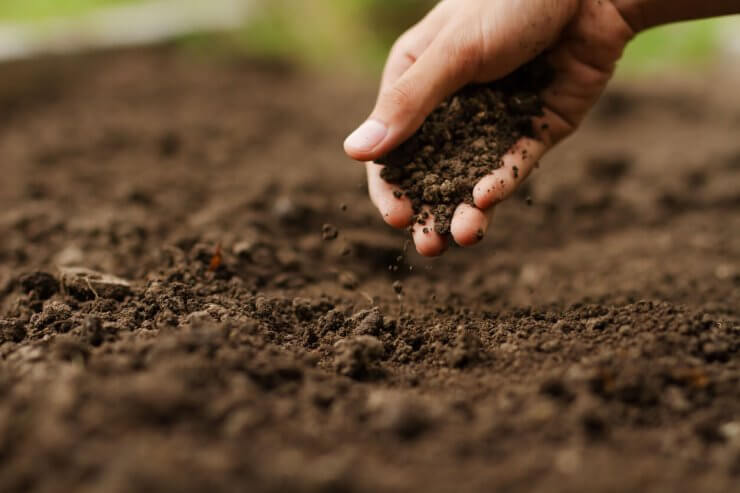
If you’re growing food, you’ll benefit from knowing exactly what your soil is made of. The “jar test” — also called the mason jar or peanut-butter-jar test — gives you a quick, hands-on look at the relative amounts of sand, silt and clay in your soil. Those three particle types determine drainage, nutrient-holding capacity, compaction risk and erosion potential, all of which are vital for healthy plants and organic food production.
Why Soil Texture Matters in Your Food Garden
Your dirt’s texture is the foundation of your garden’s success. The balance of sand, silt, and clay affects how much water it retains, how quickly it drains, and how accessible oxygen and nutrients are for roots.
Sandy earth drains quickly and resists compaction, while clay holds on to water and nutrients but can stay cool and compact easily. Silty soils fall somewhere in between, with good water-holding ability but a tendency to compact.
The most prized type — loam — offers the best of all worlds, with strong nutrient retention and adequate drainage. On sloped gardens, the right texture helps manage runoff while preventing erosion, which makes knowing your dirt’s composition even more critical.
How to Do the Jar Test Yourself
The jar test is straightforward, affordable and surprisingly fun. You only need a clear jar, some soil and a bit of patience. By letting the particles settle over time, you’ll see distinct layers that reveal how much sand, silt and clay your soil contains. Follow these steps to get an accurate picture of what’s beneath your feet:
- Collect a spade-deep soil sample in the root zone, and sift to remove any rocks, roots or debris.
- Fill a clear, straight-sided jar about one-third with dry, pulverised soil.
- Add distilled or tap water near the top, then a teaspoon of dishwashing soap or a packet of sodium hexametaphosphate. Cap tightly.
- Shake vigorously for several minutes to break up dust clumps and suspend particles.
- Set the jar on a level surface. At one minute, the bottom layer is sand. After about 2 hours, the middle layer is silt. After 24-48 hours, the top layer is clay.
- Measure each layer’s height and the total height. Then, compute percentages.
- Compare those numbers on a soil-texture triangle to identify your soil type — loam, sandy loam, clay loam and so on.
What the Results Mean for Your Garden
Once you see your soil type, you can tailor your garden practices:
- Sandy soils shed water fast. Add compost, aged manure, or peat moss to increase water and nutrient retention. Mulch heavily to reduce evaporation.
- Clay retains water but risks poor drainage and compaction. Mix in coarse sand, compost and organic matter to improve structure, and avoid walking on beds when wet. They saturate quickly during heavy spring storms since clay holds water tightly, often causing runoff or pooling in wetter regions like the Pacific Northwest. Drainage fixes such as raised beds, French drains, or grading slopes help protect both plants and property.
- Silty earth benefits from compost and coarse additives to open the structure. Avoid working when wet to prevent compaction.
- Loam soils are versatile. Adding organic matter each season keeps the structure healthy, feeds the microbes and balances pH.
Special Considerations for Sloped Gardens
On slopes, water moves downhill quickly — especially in sandy or compacted areas — leading to erosion, nutrient loss and bare patches. A lightly sandy loam enriched with compost and mulch helps rainfall soak in.
Contour beds or terracing slow down runoff. Deep-rooted cover crops such as clover, vetch, or buckwheat anchor soil and build organic matter. Avoid heavy clay without amending because it can lead to sheet erosion when saturated.
Seasonal Challenges by Soil Type
Each soil type has unique seasonal quirks. Knowing these tendencies can help you prepare your food garden before problems set in:
- Spring: Clay or silt soils stay wet and cold, so plant later or use raised beds. Sandy soils may need frequent watering, as they warm up quickly.
- Summer: Sandy soils dry rapidly, so water longer but less often and use mulch. Clay soils can crack when dry, then seal up during rain. Regular organic matter helps moderate these extremes.
- Rainy season: Erosion is a concern on slopes with sandy or silty soils. Mulch, cover crops or contour planting reduce wash-outs. Clay soils get easily compacted, so keep foot traffic light.
Picking Plants for Your Soil
Choosing plants that match your soil type makes gardening far easier. Root crops such as carrots, onions and garlic thrive in sandy or sandy-loam dirt that drains well and resists compaction. Choose drought-tolerant crops for majority-sand gardens. Leafy greens like lettuce, kale and chard prefer moderately moist loam or clay-loam, provided the earth is well aerated.
Fruit-bearing crops such as tomatoes, peppers and eggplants do well in loam with moderate clay, as sandy dirt requires extra watering and fertility. Moisture-loving crops — including broccoli and cabbage — handle heavier earth effectively.
Why the Jar Test Is Great, and Where It Can Mislead
The jar test is inexpensive, fun and helpful for gardeners. It gives you a clear visual cue of your soil composition and helps inform your amendments and plant choices. However, remember that it sometimes underestimates clay because tiny particles clump together if dispersion is incomplete. For higher accuracy, you could repeat the test with a dispersing agent or send a sample to your local Extension soil lab for professional analysis.
Let Your Soil Guide You
The jar test is more than a science experiment — it’s a practical tool that reveals what your dirt can and cannot do. By understanding your nearby balance of sand, silt and clay, you can improve drainage, reduce erosion, choose crops wisely and amend with confidence. Try the test in different parts of your garden, compare results and plan accordingly. When you let your soil guide you, you give your plants the best chance for a healthy, abundant harvest.



